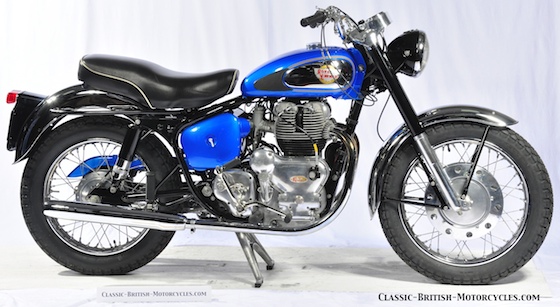
Representing the peak of Royal Enfield Motorcycles evolution, was the 750 Interceptor. This 1963 Royal Enfield Interceptor Mark I was at the first year for the 750 engine. This one happened to be at the 2011 Clubman’s All-British Weekend.
THE EARLY DAYS
Royal Enfield Motorcycles were not the best-selling Classic British Motorcycles, but they were often unique and interesting. Like so many British Motorcycle Companies at the time, Royal Enfield started out making bicycles in 1893 as the Enfield Manufacturing Company Ltd. By 1899, they’d build their first Quadricycle with a DeDion engine. They added “Royal” to the Enfield name. In 1912 they started racing with their Royal Enfield Model 80, powered by a 770cc JAP V-twin, enjoying some success at the Isle of Man TT and Brooklands.
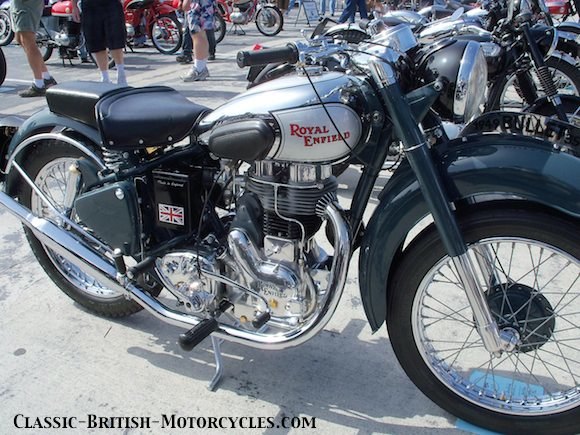
ABOVE: 1949 Royal Enfield 350 Bullet
WORLD WAR I & AFTER
WWI brought rich contracts from both the British War Department and Imperial Russia for 3 different models: a 225cc two-stroke; a 425cc V-twin; and an 8hp sidecar rig with a Vickers machine gun mounted on it. With war’s end, Royal Enfield Motorcycles concentrated on the civilian market with a new 976cc V-twin in 1921 and their first 4-stroke single, albeit with a JAP 350cc engine. Saddle tanks and center-sprung girder front forks (state-of-the-art for the day, and Royal Enfield Motorcycles was one of the first to adopt it) were added in 1928.
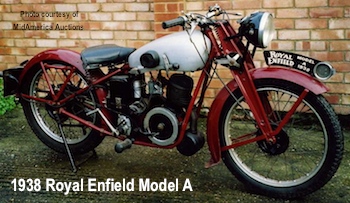
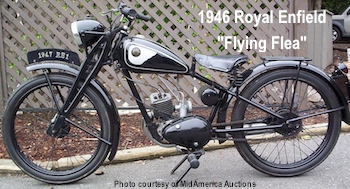
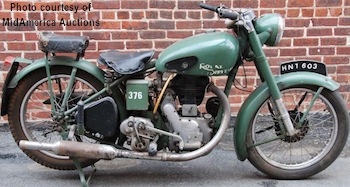
WORLD WAR II BIKES
Despite all this, the company was in dire financial straights, but limping along. In 1931, one of the founders, Albert Eddie dies, then 2 years later, his parter RW Smith dies also. Times were tough, the Depression had set in, but Royal Enfield Motorcycles managed to keep it going. WWII hit at just the right time & again they were flooded with lucrative government contracts for gobs of military motorcycles, a collection that included a 250cc side-valve (SV), a 350cc SV, two 350cc OHVs, a 570cc SV & the most famous of them all, “The Flying Flea”. The Flea was a lightweight, rugged 125cc two-stroke that could be parachuted in with airborne troops. To avoid bombing, a brand new factory was built underground in Westwood, England, where it was found that the constant temperatures were ideal for making not only motorcycles, but “predictor” detonators for anti-aircraft artillery shells. Dangerous work, that.
BUILT IN INDIA
After the war, Royal Enfield Motorcycles resumed civilian production with the 350cc OHV Model G single & the 500cc OHV Model J single, both with rigid frames & telescopic forks. In 1948 they unveiled their ground-breaking new swing arm rear suspension, one of the first to do so. By the late 1950s, Royal Enfield was struggling again financially & so sold manufacturing rights & tooling to Madras Motors in India & production of 350cc Royal Enfield Bullets commenced in India, where it continues to this day.
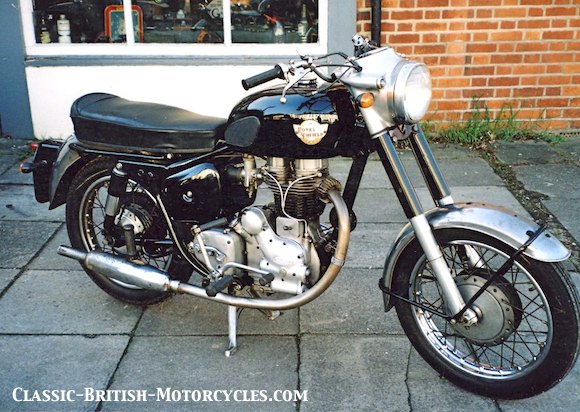
ABOVE: 1960 Royal Enfield 350 Bullet.
TWINS FROM ENGLAND
But at this point, Royal Enfield was still building bikes themselves at their Bradford-on-Avon factory in England. In 1949, they joined the Vertical Twin Race with their own 500cc Royal Enfield Meteor. By 1953, they’d punched it out to 700cc (hoping to trump Triumph & BSA who only had 650s) for the Royal Enfield Super Meteor, then again in 1962 to 750cc in the Royal Enfield Interceptor. All the while, they built lots of 18hp 250cc OHV Royal Enfield Crusaders. They also dabbled in two-strokes, like the Villiers-engined 250 Turbo Twin. Nothing seemed to add up to the sales they needed to survive.
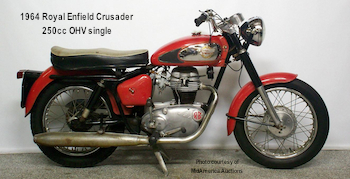
THE END DRAWS NEAR
By this time, the horsepower race was on, the Japanese were on their way and everyone was pumping up their bikes for more power. Royal Enfield followed suit with its Series I & Series II 750cc Interceptor, now good for a 13-sec quarter mile at 105 mph. The US loved the bike, but cash-strapped Royal Enfield was unable to produce them in large enough volumes quickly enough to meet the demand. That and a reputation for leaking oil (earning them the nickname “Royal Oilfield”) lead to their final slide into insolvency. By 1967, production has stopped and by 1970, the factory was closed for good, at which time Royal Enfield was acquired by Manganese Bronze Holdings and added to the scrap heap that would become Norton-Villiers (which would ultimately include Triumph, BSA, Norton, Matchless/AJS, James, Francis-Barnett, et al).
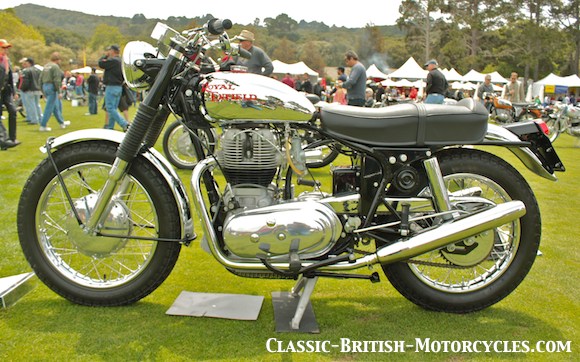
ABOVE: Last year of Interceptor production was 1970. This is a ’70 model.
SOME INTERESTING TWISTS
Another sad story of a British Motorcycle Maker failing to embrace changing times. But there were some very interesting and unique aspects to the Royal Enfield Motorcycle story. First, that they are still being produced today in India as the fuel-injected, electric-start 500cc OHV single, the Royal Enfield Bullet. This new ‘Indian Enfield’ is built in a variety of styles, some mimicking military machines and Classic British Motorcycles.



ABOVE: This 1956 Indian Trailblazer was actually a Royal Enfield Meteor-style 700cc twin, imported to the US by Indian and rebadged as an Indian Motorcycle. Note the Indian Head lighted mascot on the front fender. Even that couldn’t help sales though. It bombed.
INDIAN ENFIELDS & ENFIELD INDIANS
Another interesting twist is how Indian Motorcycles rebadged them as Indians and sold them in the US market. Interesting story. Indian had itself changed hands during WWII & after the war, the new owners wanted to get out of the heavy V-twin market and embrace the ‘new wave’ of bikes pouring in from Britain. They had tried unsuccessfully to lobby the US government to impose heavy tariffs and limits on British imports. When that failed, they decided that if you can’t beat ‘em, join ‘em. Indian squandered their dwindling resources on trying to build their own vertical twin on the British mold, but failed miserably. So, they became the exclusive US importers for Royal Enfield Motorcycles in 1953, which they promptly painted bright red and slapped Indian logos onto. And gave them very odd names like ‘Indian Chief’, ‘Tomohawk’ and ‘Hounds Fire Arrow’. Indian Motorcycles had thrown all its eggs into the Royal Enfield basket when it ended decades of production of its own V-twin. Unfortunately, the rebadged ‘Enfield Indians’ didn’t well well and so the marketing agreement was cancelled in 1960, at which point Royal Enfield Motorcycles became available in the US under their own name.
So, another oddity is that there are then “Indian Enfields” & “Enfield Indians”
3 CENTURIES OF BIKES
Lastly, Royal Enfield is the only motorcycle company still building bikes who can claim to have done so over a span of 3 centuries! Not even old-timers Triumph Motorcycles (1902) & Harley-Davidson (1903) can claim that!



